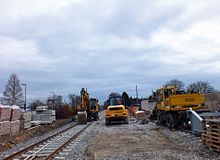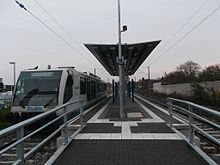Heinsberg railway station (Rhineland)
| Heinsberg (Rhineland) | |
|---|---|
| Data | |
| Location in the network | Terminus |
| Design | Terminus |
| Platform tracks | 2 |
| abbreviation | KHEB |
| IBNR | 8002721 |
| opening | 1890 |
| location | |
| City / municipality | Heinsberg |
| country | North Rhine-Westphalia |
| Country | Germany |
| Coordinates | 51 ° 3 '53 " N , 6 ° 5' 58" E |
| Railway lines | |
| Railway stations in North Rhine-Westphalia | |
The Heinsberg (Rhineland) station is a terminal station in the North Rhine-Westphalian district town of Heinsberg and the end point of the Lindern – Heinsberg (Rheinl) railway line . The station building and goods shed were gradually demolished after passenger traffic was discontinued in 1980, goods traffic to Heinsberg in 1994 and sections of the route between Oberbruch and Heinsberg were closed in 1997. As part of the reactivation of the line for passenger traffic on December 15, 2013, a new central platform was built a little east of the location of the demolished reception building.
location
The station is located on the northeastern edge of the city center. Next to the station area is the Heinsberg Galerie , a shopping center . The station bordered on the east of the Heinsberg industrial park, in which a timber shop had a siding.
history
1890-1980
With the construction of the Heinsberger Bahn, also known as the Wurmtalbahn, Heinsberg got a rail connection for the first time in 1890. After lengthy and unsuccessful deliberations to continue building the railway line, the station was built as a terminus . The reception building at that time stood on the site between the bus station and today's medical center. It was almost identical to that of the neighboring Dremmen station , but the signal box was located in the reception building and not in a glass extension, as in Dremmen. There were two waiting rooms in Heinsberg. Goods handling with its own loading platform was directly connected to the reception building .
The station was destroyed in the Second World War. The remains of the reception building were torn down and never rebuilt. Instead, a wooden barrack was created as a transition station. The track system was renewed by volunteers to the bare minimum.
It was not until 1951 that a new station building could be opened, which had a separate goods area further south. A glass porch stood next to the tracks and the platform, similar to the one in Dremmen. This was where the signal box and ticket sales were located. All sides of the platform were covered. There was also a roof from the street side. Passenger traffic was handled on only one track, the remaining tracks were goods and sidings for the timber and gas works. Passenger traffic was stopped in 1980. A few years later the station building was demolished to make way for a new bus station. The track systems were partially dismantled to make room for the Heinsberg Gallery .
Since 2010
Heinsberg was originally supposed to be accessible again in the rail network from 2008, but the reactivation of the railway line was delayed due to funding cuts, so that at that time it was assumed that it would be reactivated in 2012. With the sale of the route by Deutsche Bahn to the new owners WestEnergie und Verkehr , the Rurtalbahn became the new operator of the infrastructure. In October 2011, in the first edition of the West-Express, a publication by the infrastructure operator Rurtalbahn, it was announced that a double-track terminus with a park-and-ride system would be built in Heinsberg in the future . The travel time from Lindern to Heinsberg should be 17 minutes including the stops.
In the spring of 2010, the section from Heinsberg to Oberbruch was cut open. The train of remembrance was able to pass the route to the Heinsberg district building in the same spring. With the cut-out, the poor condition of the tracks in the section mentioned became clear. An exchange could not be avoided, especially in the Heinsberg station area.
In June 2012, the old track systems in the Heinsberg train station were removed, the remaining loading ramp and the remaining foundations for goods handling were demolished and a new subgrade was created. The new station tracks and platform as well as the P + R parking lot were set up on the new planum. The platform tracks are end tracks, so that it is not possible to move locomotives in the station.
In July 2013, the P + R parking lot, the platform and the platform roof were largely completed. So that the traffic to the train station does not have to drive through the city center, the car park can only be reached by motor vehicle via an entrance from Industriestrasse.
Since December 15, 2013 the Rhein-Niers-Bahn has been running every hour from Heinsberg towards Aachen Hauptbahnhof . The trains are winged in Lindern station .
| line | Train run | Clock frequency |
|---|---|---|
| RB 33 |
Rhein-Niers-Bahn : Heinsberg (Rheinl) - Heinsberg Kreishaus - Heinsberg-Oberbruch - Heinsberg-Dremmen - Heinsberg-Porselen - Heinsberg-Horst - Heinsberg-Randerath - Lindern - Geilenkirchen - Übach-Palenberg - Herzogenrath - Kohlscheid - Aachen West - Aachen Schanz - Aachen Hbf Status: timetable change December 2019 |
60 min |
Bus connections
Numerous buses run in different directions from Heinsberg train station . The city buses with the 400 numbers only run during the week. In addition, the MultiBus runs as an on- demand service . The bus routes are operated by WestVerkehr . In 2008 Veolia Transport Nederland's line 179 temporarily drove to Roermond . Since December 2016, when Arriva Personenvervoer Nederland took over the bus transport in the Dutch province of Limburg, their line 364 has been running to Roermond, which was renamed 64 at the end of 2017. There are three bus platforms and two taxi platforms at the bus station .
Freight depot
In addition to the freight facilities at the station, the timber and gas works also had their own connections. The connection to the gasworks was shut down and dismantled before 2010, that of the timber trade was not dismantled in 2011. Since freight traffic was only stopped in 1985, five years after passenger traffic, only the station building was demolished, but not the goods handling facility. This was only demolished in 2003. In 2010 the station area still showed the loading ramp for goods and beets. The foundation of the goods handling was still clearly visible until August 2012. With the resumption of passenger traffic, all rails between Oberbruch and Heinsberg were relocated. The former siding and other objects that pointed to the old freight yard were removed.
See also
literature
- Wilhelm Frenken in the home calendar of the Heinsberg district in 1982: The one hundred year history of passenger transport on the Heinsberg-Lindern railway line
- Willi Tetz in the home calendar of the Heinsberg district 2007: Lindern and the railway
- Willi Melchers in the home calendar of the district of Heinsberg 2008: The circus is coming (including the description of the arrival at the train station with railway facilities)
Web links
- Current departure plan from Heinsberg (Rheinl). Deutsche Bahn , accessed on December 29, 2015 .
- Departure monitor. Exit Heinsberg, bus station. Aachen Transport Association , accessed on December 29, 2015 .
- Heinsberg bus station. (PDF file; 324 KB) In: Stop location plans. Aachen Transport Association , June 2015, accessed on December 29, 2015 .
- Reinhard Gessen: reactivation of Heinsberg-Lindern. In: Mining and railways in the Aachen-Düren-Heinsberg region. Reinhard Gessen, accessed on December 29, 2015 .
- Stefan von der Ruhren: Course book route 456 Lindern - Heinsberg. In: Railways in Aachen and the Euregio Meuse-Rhine. Stefan von der Ruhren, November 11, 2014, accessed on December 29, 2015 .
- André Joost: Heinsberg (Rheinl) branch. In: NRWbahnarchiv-Betriebsstellearchiv. André Joost, accessed December 29, 2015 .
- André Joost: Heinsberg train station (Rheinl). In: NRWbahnarchiv-Bahnhofsinfo. André Joost, accessed January 12, 2016 .
Individual evidence
- ↑ Johannes Bindels: The Heinsberg train station in the mirror of the times. In: Aachener Nachrichten . Aachener Zeitungsverlag , March 24, 2014, accessed on December 29, 2015 .
- ↑ AZ / AN of March 1, 2008, target network of the avv for 2012
- ↑ State Secretary and 300 guests on the maiden voyage. In: Aachener Nachrichten . Aachener Zeitungsverlag , December 15, 2013, accessed on December 29, 2015 .






